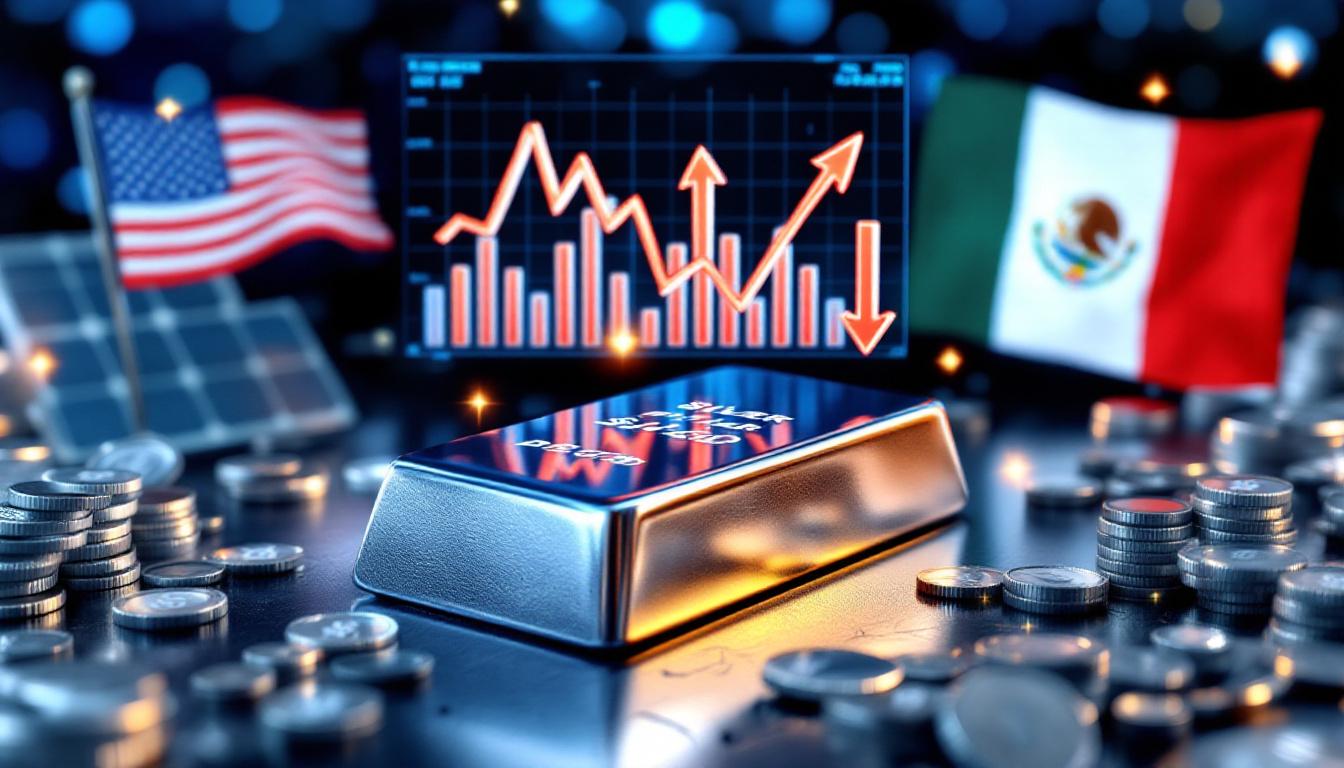As global trade tensions escalate in 2025, the Australian Securities Exchange (ASX) finds itself navigating unprecedented volatility. Tariff fears impact on ASX 2025 are evident as investors adjust to uncertainty. President Trump's renewed tariff threats – trump's policies reshaping commodity markets sent shockwaves through global markets. The ASX remains resilient despite broader international declines.
Australia’s economy, heavily reliant on commodity exports, is now closely intertwined with Western financial markets. Investors are watching commodities and safe-haven assets. Gold, for instance, has reached an all-time high of US$2,990.02 per ounce, highlighting growing interest in defensive assets. This sentiment is further fuelled by the tariff-driven surge in gold prices.
What Caused the ASX's Weekly Decline Despite Friday's Rally?
The ASX 200 recorded its worst weekly performance of 2025, falling almost 2% for the week ending March 14. Despite Friday’s recovery – the index gained 0.5% (40.6 points) and closed at 7,789.7 points – the overall sentiment remained fragile.
President Trump's threat to impose 200% tariffs on European wine, in retaliation for a 50% levy on American whiskey, sparked the initial turbulence. This move contributed to a 10% technical correction in US markets. For further context on market influences, consider this article by australian market downturn.
Market analysts noted, "The decoupling we're witnessing between Australian and US markets represents a significant shift in traditional correlation patterns." This divergence suggests investors are beginning to price in Australia’s unique position amid shifting global trade dynamics.
News of the US narrowly avoiding a government shutdown provided a temporary relief valve. Although the ASX 200 saw improvements, the Small Ords Index finished down 1.68% at 3,004.3 points. This indicates that smaller companies remain more vulnerable to trade uncertainty compared to their larger counterparts.
How Are Mining Stocks Performing Amid Global Trade Tensions?
Mining stocks have become unexpected beneficiaries of the current trade environment. Iron ore futures in Singapore climbed 1.3% to US$103.55 per tonne, bolstered by China's continued infrastructure spending. The focus on raw materials is critical as protectionist policies become more prevalent.
Major miners exhibited impressive strength on Friday. BHP (ASX: BHP) climbed 1.1% to $38.65, Rio Tinto (ASX: RIO) increased 1% to $117.10, and Fortescue (ASX: FMG) surged 2.7% to $16.27. These gains reflect a broader confidence in strategic commodity investments. Investors also refer to 2025 mining and finance predictions for insights on this dynamic.
Gold has been the standout performer. With prices reaching a new record, precious metals continue to attract safe-haven flows. Many experts suggest that this trend reflects broader concerns over global stability. For those interested in more detailed analysis, there are insights into gold price trends available.
The lithium sector also began recovering after months of pressure. Liontown Resources (ASX: LTR) rose 4.9% to 65¢, while Catalyst Metals (ASX: CYL) rallied 5.2% to $4.64 following its Plutonic East production milestone. These developments underscore the idea that individual company achievements continue to drive performance despite a challenging market backdrop.
Why Are Banking Stocks Underperforming in the Current Market?
Banking stocks have emerged as primary casualties amid the escalating trade tensions. Major banks have witnessed notable declines, with Commonwealth Bank (ASX: CBA) falling 1.1% to $142.36. Westpac (ASX: WBC) and ANZ (ASX: ANZ) also experienced minor declines, while National Australia Bank (ASX: NAB) emerged modestly positive with a 0.3% increase.
This underperformance is driven by growing concerns over banks’ exposure to a potential economic slowdown. Compressed net interest margins and uncertainty about credit quality have also contributed to the woes. Businesses continue to face disrupted supply chains, which further undermine profitability in the financial sector.
ANZ's recent announcement of a government partnership involving up to $2 billion in guarantees for its Pacific operations garnered significant attention. This move aims to secure essential banking services in a turbulent economic environment.
Energy stocks have similarly been affected. Woodside Energy (ASX: WDS) fell 1.4% to $22.38 amidst concerns regarding global demand. The performance of these stocks underscores the sensitivity of sectors that rely heavily on global consumption patterns. Recent commentary in wall street sell-off further illustrates the challenges exposed by tariff fears.
Which Companies Are Bucking the Negative Trend?
Certain companies have managed to defy the broader market trend. Despite significant volatility, a few sectors have positioned themselves to benefit from easing domestic pressures. For example, A2 Milk (ASX: A2M) posted an 8.8% gain to $8.65. This success is largely attributed to expectations that Chinese authorities will introduce new measures to boost domestic consumption.
Market strategists note, "A2 Milk's rally demonstrates how companies deeply embedded in the chinese market can mitigate export challenges." Its strong brand presence in China’s infant formula sector serves as a buffer against adverse global trade effects.
Retail giant Myer (ASX: MYR) also fared well, rising 1.4% to 75¢ after restructuring its executive team to focus on digital transformation. This effort indicates that operational improvements can drive value, even when external economic conditions are challenging.
Out of 11 market sectors, seven closed higher on Friday. Defensive sectors such as utilities and miners recorded the strongest gains, underscoring the selective nature of market recovery. Investors are increasingly concentrating on companies capable of weathering trade uncertainties.
What Economic Data Should Investors Watch in the Coming Week?
Australian job figures, scheduled for release on Thursday, will be a key highlight. Economists project an addition of approximately 30,000 jobs in February, with the unemployment rate holding steady at 4.1%. These data points will help decipher whether tariff fears are beginning to affect domestic labour markets.
- Employment figures as a lagging indicator of economic health.
- Central bank decisions and rate holds by the US Federal Reserve, Bank of Japan, and Bank of England.
- Chinese economic activity, including retail spending and industrial production.
Analysis shows that any deviation from the projected job growth could signal wider implications for Australia’s economy. Investors should also watch central bank boards carefully. A coordinated decision to hold rates may offer insights into how global authorities manage this period of uncertainty.
Chinese monthly economic indicators, such as increases in industrial production and fixed asset investments, are also crucial. Deviations from expected growth in these metrics could critically impact Australian resource companies and those with significant exposure to China.
How Might Future Tariff Announcements Impact Market Stability?
Future tariff announcements by President Trump continue to be a dominating influence on market sentiment. Each policy statement creates a ripple effect across global equities. The ASX remains particularly vulnerable given Australia’s extensive economic ties with China.
There is a high probability that market volatility will persist. Sectors with international exposure may confront increased uncertainty, while resource companies with significant Chinese clientele will be particularly sensitive. As the situation evolves, investors are preparing for further divergence between US and Australian markets.
Gold’s persistent strength reinforces the appeal of safe-haven assets during geopolitical and trade-related turbulence. The trend provides evidence that global commodities market insights can guide investors through such turbulent times.
Market technicians add, "The divergence between global indices signals an underlying realignment that could redefine future market correlations." This observation further emphasises how tariff fears impact on ASX 2025 and related sectors.
FAQ: Understanding ASX Performance Amid Global Trade Tensions
How has the ASX 200 performed compared to global markets during recent tariff tensions?
The ASX 200 showed unusual independence from US market trends. Despite a volatile week, it managed a partial recovery, suggesting that Australian equities may offer diversification benefits during periods of trade-induced uncertainty. The decoupling may provide a safe harbour from US market swings.
Which sectors are most vulnerable to escalating trade tensions?
Banking and energy sectors are especially sensitive to economic slowdown fears and changes in global demand. Meanwhile, the mining sector, particularly gold producers, benefits from safe-haven flows. Investors are urged to consider the risks associated with each sector.
What economic indicators should be monitored for market direction?
- Central bank decisions
- Australian employment data
- Chinese economic activity
Each of these indicators provides insights into how tariff fears impact on ASX 2025 and global market dynamics. Monitoring these factors can guide effective investment strategies.
What Investment Strategies May Prove Effective in the Current Climate?
Investors may consider several strategies when facing persistent tariff fears impact on ASX 2025. For instance:
- Allocating to gold miners and precious metals producers, who gain from safe-haven demand.
- Focusing on companies with robust exposure to Chinese domestic consumption, such as A2 Milk.
- Considering defensive sectors like utilities for portfolio stability.
- Monitoring individual production milestones that can drive share price performance.
With gold nearing the psychological $3,000 mark, companies with efficient production profiles present a compelling case for investment. Meanwhile, selective investments in resilient sectors could provide necessary stability during turbulent periods.
Each strategy offers distinct benefits. As market dynamics continue to evolve, investors must remain agile and adapt to both the macroeconomic outlook and specific company fundamentals. Tariff fears impact on ASX 2025 remains a central consideration in shaping these strategies.
Searching for ASX Trading Opportunities During Market Volatility?
Discover high-potential ASX mineral announcements in real-time with Discovery Alert's proprietary Discovery IQ model, which turns complex market data into actionable insights during these uncertain trade conditions. Explore how major mineral discoveries can lead to significant market returns by visiting our dedicated discoveries page and position yourself ahead of the market.




